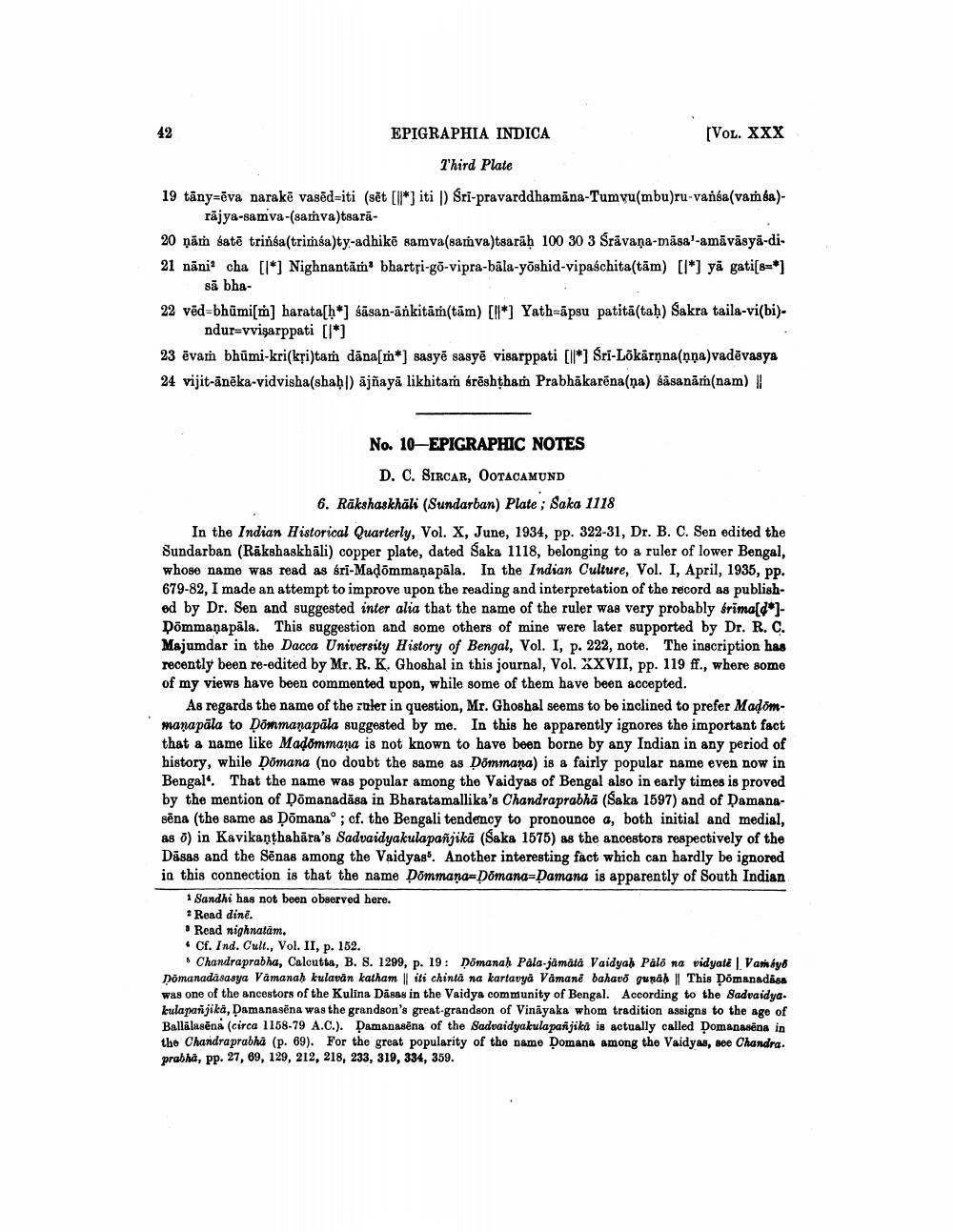________________
EPIGRAPHIA INDICA
[VOL. XXX
Third Plate 19 tāny=ēva narakē vasēd=iti (sēt [1]*] iti 1) Sri-pravarddhamāna-Tumvu(mbu)ru-vansa(vamsa)
rājya-samva-(samva)tsarā 20 ņām satē trinsa(trimsa)ty-adhikē samva(samva)tsarāḥ 100 30 3 Srāvaņa-māsa'-amāvāsya-di21 nānicha [l*] Nighnantām bhartși-go-vipra-bāla-yoshid-vipaschita(tām) [l*) yā gati[8=*]
sā bha22 vēd=bhūmi[m] harata[h*] sāsan-ānkitām(tām) [ll*] Yath=āpsu patitā(tah) Sakra taila-vi(bi)
ndur=vvisarppati [l*] 23 ēvam bhūmi-kri(kți)tam dāna[m*) sasyē sasyē visarppati [ll*] Sri-Lökārņnanna)vadēvasya 24 vijit-ānēka-vidvisha(shah]) ajñayā likhitam érēshtham Prabhākarēna(na) śāsanām(nam) ||
No. 10-EPIGRAPHIC NOTES
D. C. SIRCAR, OOTACAMUND
6. Rākshaskhāli (Sundarban) Plate ; Saka 1118 In the Indian Historical Quarterly, Vol. X, June, 1934, pp. 322-31, Dr. B. C. Sen edited the Sundarban (Rākshaskhāli) copper plate, dated Saka 1118, belonging to a ruler of lower Bengal, whose name was read as sri-Madommaņapāla. In the Indian Culture, Vol. I, April, 1935, pp. 679-82, I made an attempt to improve upon the reading and interpretation of the record as published by Dr. Sen and suggested inter alia that the name of the ruler was very probably srima[d]Dommaņapāla. This suggestion and some others of mine were later supported by Dr. R. C. Majumdar in the Dacca University History of Bengal, Vol. I, p. 222, note. The inscription has recently been re-edited by Mr. R. K. Ghoshal in this journal, Vol. XXVII, pp. 119 ff., where some of my views have been commented upon, while some of them have been accepted.
As regards the name of the ruler in question, Mr. Ghoshal seems to be inclined to prefer Madömmanapāla to Dõmmanapāla suggested by me. In this he apparently ignores the important fact that a name like Madommana is not known to have been borne by any Indian in any period of history, while Domana (no doubt the same as Dommana) is a fairly popular name even now in Bengal. That the name was popular among the Vaidyas of Bengal also in early times is proved by the mention of Domanadāsa in Bharatamallika's Chandraprabhā (Saka 1597) and of Damanasēna (the same as Domana'; cf. the Bengali tendency to pronounce a, both initial and medial, as ā) in Kavikanthahāra's Sadvaidyakulapañjikā (Saka 1575) as the ancestors respectively of the Dāsas and the Sēnas among the Vaidyas'. Another interesting fact which can hardly be ignored in this connection is that the name Dommana-Domana-Damana is apparently of South Indian
* Sandhi has not been observed here. ? Read dinē. • Read nighnatām. • Cf. Ind. Cult., Vol. II, p. 152.
• Chandraprabha, Caloutta, B. S. 1299, p. 19: Domanah Pala-jamäta Vaidyal Palo na vidyate | Vamsys Pomanadāsasya Vamanah kulavan katham | iti chinta na kartavyä Vamanė bahavo gunah | This Domanadisa was one of the ancestors of the Kulina Dåsas in the Vaidya community of Bengal. According to the Sadvaidya. kulapanjika, Damanasēna was the grandson's great-grandson of Vinayaka whom tradition assigns to the age of Ballalasēna (circa 1158-79 A.C.). Pamanasēna of the Sadvaidyakulaparijika is actually called Domanasena in the Chandraprabha (p. 69). For the great popularity of the name Domana among the Vaidyas, see Chandra. prabha, pp. 27, 69, 129, 212, 218, 233, 319, 334, 359.




